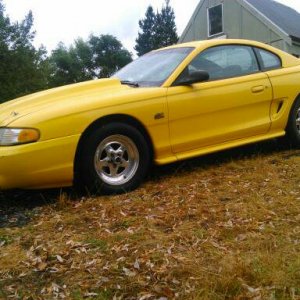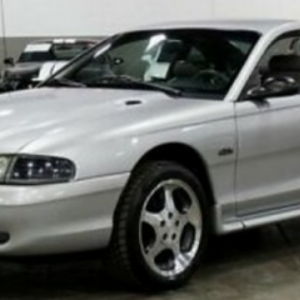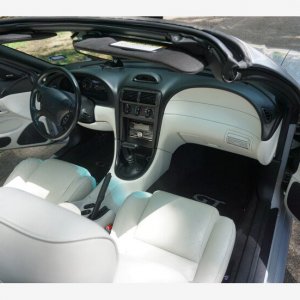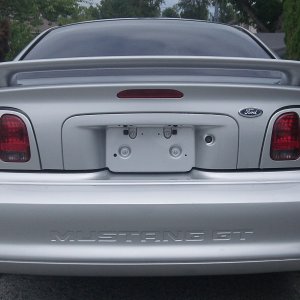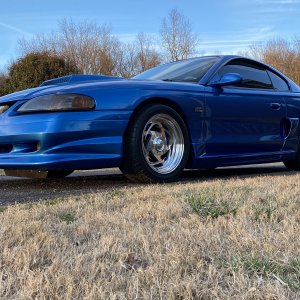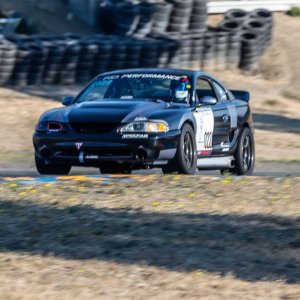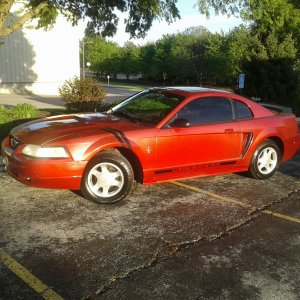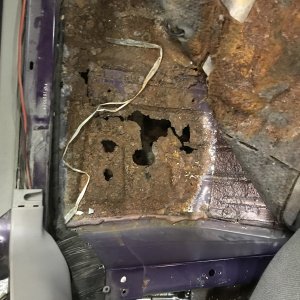Hey guys,
Sorry for putting this together in pieces. It's finished now so no worries. Basically I got this information from my Ford Mustang Book I've had. I had to type everything out and scan the pictures to the computer. I ended up just cutting the pages out so that I could scan them properly. :undecided:
Oh well, I'll just buy another one down the road. I wanted this information for everyone! This site is dedicated to the SN95 Community so I thought it would be cool for you all to read. Here are write ups for 1994 - 1998. I'll put together a 1999 - 2004 when I get everything typed out and scanned.
I hope you enjoy this information.
- Will :thumbsup:
-------------------------------------------------------------------------------------------------------------------------------------------------------------------------------------------------
Ford Motor Company gave the best present possible to Mustang enthusiasts for the popular marque’s 30th birthday in 1994- an all- new Mustang! Well, to be truthful, the car did have 500 carried-over Fox components, such as the powertrain, floorpans, and brackets tucked out of sight, but a stylish new body made everyone forget that its squarish predecessor had stayed on the market several years too long.
Ford’s Team Mustang introduced the 1994 model on October 15, 1993, after spending three years in an old Montgomery Ward warehouse south of Dearborn. The new Mustang featured grille opening and a body entirely free of sharp edges. The melted-soap styling was attractive, but not aggressively so. It was designed to offend no one, and many cues from the past (such as the long-hood/short-deck profile, functional side vents, and three-element taillights) endeared the car to a new generation of enthusiasts. Considering the group was given a limited budget, it is remarkable that the 1994 model looks so radically different from the 1993 version.
Team Mustang was given a mandate to eradicate the body flex and noise problems inherent in the Fox chasis. The final product, which was know internally as the SN-95, surpassed its rigidity goals, registering an 80 percent improvement in the convertible’s chassis torsion and a 44 percent increase in the closed model. New technologies contributed to the stiffness, including bonding the front and rear glass to their frames with a rigid urethane glue and making thicker rocker panels and roof rails. The new car also met upcoming federal crash standards that required slamming a 3,000- pound test sled into the vehicle’s side at 33 miles per hour.
At 181.5 inches from bumper to bumper, the SN-95 was 2.4 inches longer than the Fox had been when it debuted in 1979. The wheelbase of 101.3 inches was a 0.9-inch stretch. Width grew by 2.8 inches to 71.9, and the new roofline was 1.4 inches higher at 52.9 inches.
As of 1994, the Mustang would no longer be available as a notchback, hatchback, and convertible. Instead, Ford created a coupe whose sporty greenhouse suggested a fastback roof- similar to what the original 2+2 had in 1965- and developed a convertible from that platform. Tuning noise, vibration, and harshness out of the ragtop’s body meant installing a 25-pound mass damper inside the right front fender well.
Ford hoped to rekindle the kind of Mustang fervor that had led to near-riots at dealerships in 1964, and its advertising drew direct comparisons to the original model. Magazine ads claimed, “It is what it was.” Hundreds of thousands of posters and cards were distributed at car shows displaying a new convertible pony alongside a 1965 droptop. Ford’s marketers worked hand-in-hand with the Mustang Club of America and similar organizations to ensure that vintage Mustang collectors, restorers, and modifiers had every chance to fall in love again.
Dropping the complex multilevel trim packages of the past, Ford offered the 1994 with two body styles, two engine choices (V-6 and V-8), two transmissions (five-speed manual and four-speed automatic), 11 exterior colors (including Canary Yellow, three shades of red, Bright Blue, and Deep Forest Green), and five interior colors. The V-6 cars were known simply as Mustangs; V-8 models were exclusively Mustang GTs. Prices for the latest version of this American icon were reasonable-$13,355 for the base coupe and $20,150 in convertible form. Moving up to the GT level meant paying $17,270 for a coupe and $21,960 for a convertible. The standard equipment list was longer than ever. It included dual, electric, remote-control mirror; four-speaker stereo; air bags for driver and passenger; console with arm rest; driver-side foot rest; full instrumentation; dual visor mirrors; four-way powered driver’s seat; tilt steering; side window demisters; and extensive Light Group package; and reclining cloth bucket seats with head restraints. Convertibles featured power retractable tops with protective covers, illuminated visor mirrors, power door locks and windows.
In spite of what the advertisements said, in terms of creature comforts, the new base Mustang was much better outfitted than buyers of the 1965 model could have dreamed.

1994 GT
Price: $13,355 (base) $17,270 (GT)
Engine: 5.0-liter V-8, 215 horsepower
0-60 mph: 6.7 seconds (GT)
Top Speed: 140 mph (GT)
Mustang engine choices changed slightly for 1994. The four cylinder essentially the same 2.3 liter plant introduced in the 1974 Mustang II – was dropped.
Base Mustangs received a version of the same 3.8 liter, 145-horsepower v-6 that had been pulling heavier Taurus, Thunderbird, and Lincoln Continental models for several years. Giving the cheapest pony a 38 percent increase in power. The 5.0-liter v-8, a Mustang staple since 1968 received a minor boost to 215 horsepower at 4,200 rpm by way of low profile intake manifold and hypereutectic aluminum alloy pistons.
Rolling stock was improved with the SN-95 design. Base V-6 Mustangs wore 15-inch steel wheels with plastic covers and 205/65-15 all-season black sidewall Goodyear Eagle GA tires. For a few extra bucks, those same Goodyears could be fitted to three-spoke alloy wheels. GT rims were five-spoke, 16 inch designs wearing 225/55-16 Firestone Firehawk rubber, or buyers could upgrade to three spoke 17-inchers with wide 245/45-17 Goodyear Eagle GTs.
For the first time in Mustang history, all models received four-wheel disc brakes. An anti-lock brake system was optional. Although sales of the 1994 were nowhere near that of the ’65 model, Ford happily pumped out 123,198 of the new Mustangs. The most popular configuration was the V-6 coupe, at 42,883 units.
Did you know?
Of the SN-95’s 1,850 parts, 1,330 were new. To demonstrate how little the ’94 Mustang shared with the ’93, Ford mounted a stripped ’94 chassis on a rotisserie with color-coded parts indicating carryover components. This “Mustang on a spit” was displayed at car shows around the country.


Sorry for putting this together in pieces. It's finished now so no worries. Basically I got this information from my Ford Mustang Book I've had. I had to type everything out and scan the pictures to the computer. I ended up just cutting the pages out so that I could scan them properly. :undecided:
Oh well, I'll just buy another one down the road. I wanted this information for everyone! This site is dedicated to the SN95 Community so I thought it would be cool for you all to read. Here are write ups for 1994 - 1998. I'll put together a 1999 - 2004 when I get everything typed out and scanned.
I hope you enjoy this information.
- Will :thumbsup:
-------------------------------------------------------------------------------------------------------------------------------------------------------------------------------------------------
Ford Motor Company gave the best present possible to Mustang enthusiasts for the popular marque’s 30th birthday in 1994- an all- new Mustang! Well, to be truthful, the car did have 500 carried-over Fox components, such as the powertrain, floorpans, and brackets tucked out of sight, but a stylish new body made everyone forget that its squarish predecessor had stayed on the market several years too long.
Ford’s Team Mustang introduced the 1994 model on October 15, 1993, after spending three years in an old Montgomery Ward warehouse south of Dearborn. The new Mustang featured grille opening and a body entirely free of sharp edges. The melted-soap styling was attractive, but not aggressively so. It was designed to offend no one, and many cues from the past (such as the long-hood/short-deck profile, functional side vents, and three-element taillights) endeared the car to a new generation of enthusiasts. Considering the group was given a limited budget, it is remarkable that the 1994 model looks so radically different from the 1993 version.
Team Mustang was given a mandate to eradicate the body flex and noise problems inherent in the Fox chasis. The final product, which was know internally as the SN-95, surpassed its rigidity goals, registering an 80 percent improvement in the convertible’s chassis torsion and a 44 percent increase in the closed model. New technologies contributed to the stiffness, including bonding the front and rear glass to their frames with a rigid urethane glue and making thicker rocker panels and roof rails. The new car also met upcoming federal crash standards that required slamming a 3,000- pound test sled into the vehicle’s side at 33 miles per hour.
At 181.5 inches from bumper to bumper, the SN-95 was 2.4 inches longer than the Fox had been when it debuted in 1979. The wheelbase of 101.3 inches was a 0.9-inch stretch. Width grew by 2.8 inches to 71.9, and the new roofline was 1.4 inches higher at 52.9 inches.
As of 1994, the Mustang would no longer be available as a notchback, hatchback, and convertible. Instead, Ford created a coupe whose sporty greenhouse suggested a fastback roof- similar to what the original 2+2 had in 1965- and developed a convertible from that platform. Tuning noise, vibration, and harshness out of the ragtop’s body meant installing a 25-pound mass damper inside the right front fender well.
Ford hoped to rekindle the kind of Mustang fervor that had led to near-riots at dealerships in 1964, and its advertising drew direct comparisons to the original model. Magazine ads claimed, “It is what it was.” Hundreds of thousands of posters and cards were distributed at car shows displaying a new convertible pony alongside a 1965 droptop. Ford’s marketers worked hand-in-hand with the Mustang Club of America and similar organizations to ensure that vintage Mustang collectors, restorers, and modifiers had every chance to fall in love again.
Dropping the complex multilevel trim packages of the past, Ford offered the 1994 with two body styles, two engine choices (V-6 and V-8), two transmissions (five-speed manual and four-speed automatic), 11 exterior colors (including Canary Yellow, three shades of red, Bright Blue, and Deep Forest Green), and five interior colors. The V-6 cars were known simply as Mustangs; V-8 models were exclusively Mustang GTs. Prices for the latest version of this American icon were reasonable-$13,355 for the base coupe and $20,150 in convertible form. Moving up to the GT level meant paying $17,270 for a coupe and $21,960 for a convertible. The standard equipment list was longer than ever. It included dual, electric, remote-control mirror; four-speaker stereo; air bags for driver and passenger; console with arm rest; driver-side foot rest; full instrumentation; dual visor mirrors; four-way powered driver’s seat; tilt steering; side window demisters; and extensive Light Group package; and reclining cloth bucket seats with head restraints. Convertibles featured power retractable tops with protective covers, illuminated visor mirrors, power door locks and windows.
In spite of what the advertisements said, in terms of creature comforts, the new base Mustang was much better outfitted than buyers of the 1965 model could have dreamed.

1994 GT
Price: $13,355 (base) $17,270 (GT)
Engine: 5.0-liter V-8, 215 horsepower
0-60 mph: 6.7 seconds (GT)
Top Speed: 140 mph (GT)
Mustang engine choices changed slightly for 1994. The four cylinder essentially the same 2.3 liter plant introduced in the 1974 Mustang II – was dropped.
Base Mustangs received a version of the same 3.8 liter, 145-horsepower v-6 that had been pulling heavier Taurus, Thunderbird, and Lincoln Continental models for several years. Giving the cheapest pony a 38 percent increase in power. The 5.0-liter v-8, a Mustang staple since 1968 received a minor boost to 215 horsepower at 4,200 rpm by way of low profile intake manifold and hypereutectic aluminum alloy pistons.
Rolling stock was improved with the SN-95 design. Base V-6 Mustangs wore 15-inch steel wheels with plastic covers and 205/65-15 all-season black sidewall Goodyear Eagle GA tires. For a few extra bucks, those same Goodyears could be fitted to three-spoke alloy wheels. GT rims were five-spoke, 16 inch designs wearing 225/55-16 Firestone Firehawk rubber, or buyers could upgrade to three spoke 17-inchers with wide 245/45-17 Goodyear Eagle GTs.
For the first time in Mustang history, all models received four-wheel disc brakes. An anti-lock brake system was optional. Although sales of the 1994 were nowhere near that of the ’65 model, Ford happily pumped out 123,198 of the new Mustangs. The most popular configuration was the V-6 coupe, at 42,883 units.
Did you know?
Of the SN-95’s 1,850 parts, 1,330 were new. To demonstrate how little the ’94 Mustang shared with the ’93, Ford mounted a stripped ’94 chassis on a rotisserie with color-coded parts indicating carryover components. This “Mustang on a spit” was displayed at car shows around the country.






























